Analyzing the Significance of Human Resource Management Systems
VerifiedAdded on 2021/06/16
|8
|1633
|34
Report
AI Summary
This report analyzes the significance of Human Resource Management (HRM) systems within organizations. It emphasizes how HRM protects stakeholder rights, enhances recruitment and selection processes, and boosts overall organizational effectiveness. The report explores the benefits of HRMS, including improved worker performance and productivity, cost-effectiveness, and the maintenance of a positive work environment. Furthermore, it highlights how HRM facilitates effective communication, performance evaluation, and employee engagement. The report also underscores the role of HRM in sustainable business practices, data management, and the development of a skilled workforce. It concludes that a robust HRM system is essential for organizational growth, ensuring transparency and adaptation to change.
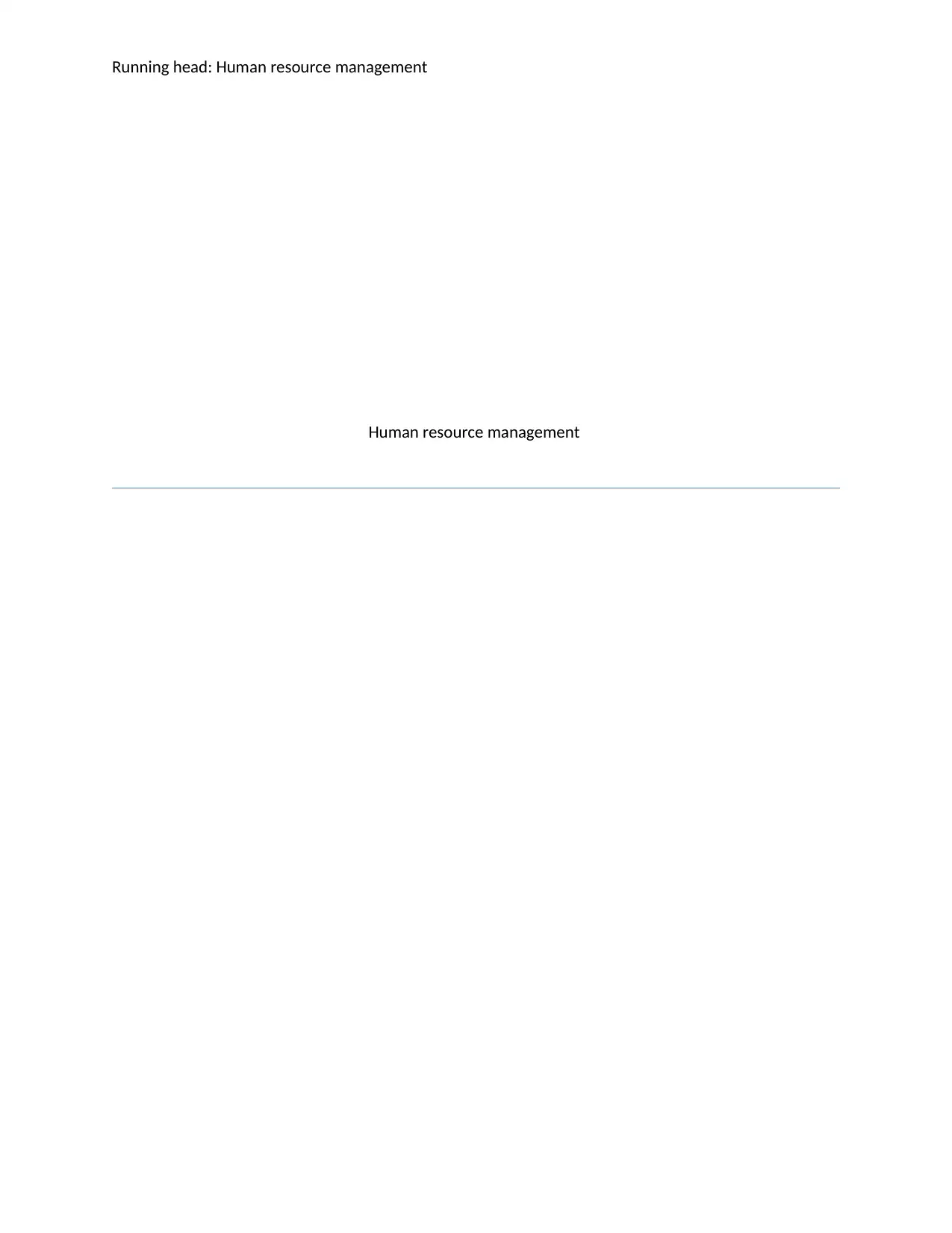
Running head: Human resource management
Human resource management
Human resource management
Paraphrase This Document
Need a fresh take? Get an instant paraphrase of this document with our AI Paraphraser
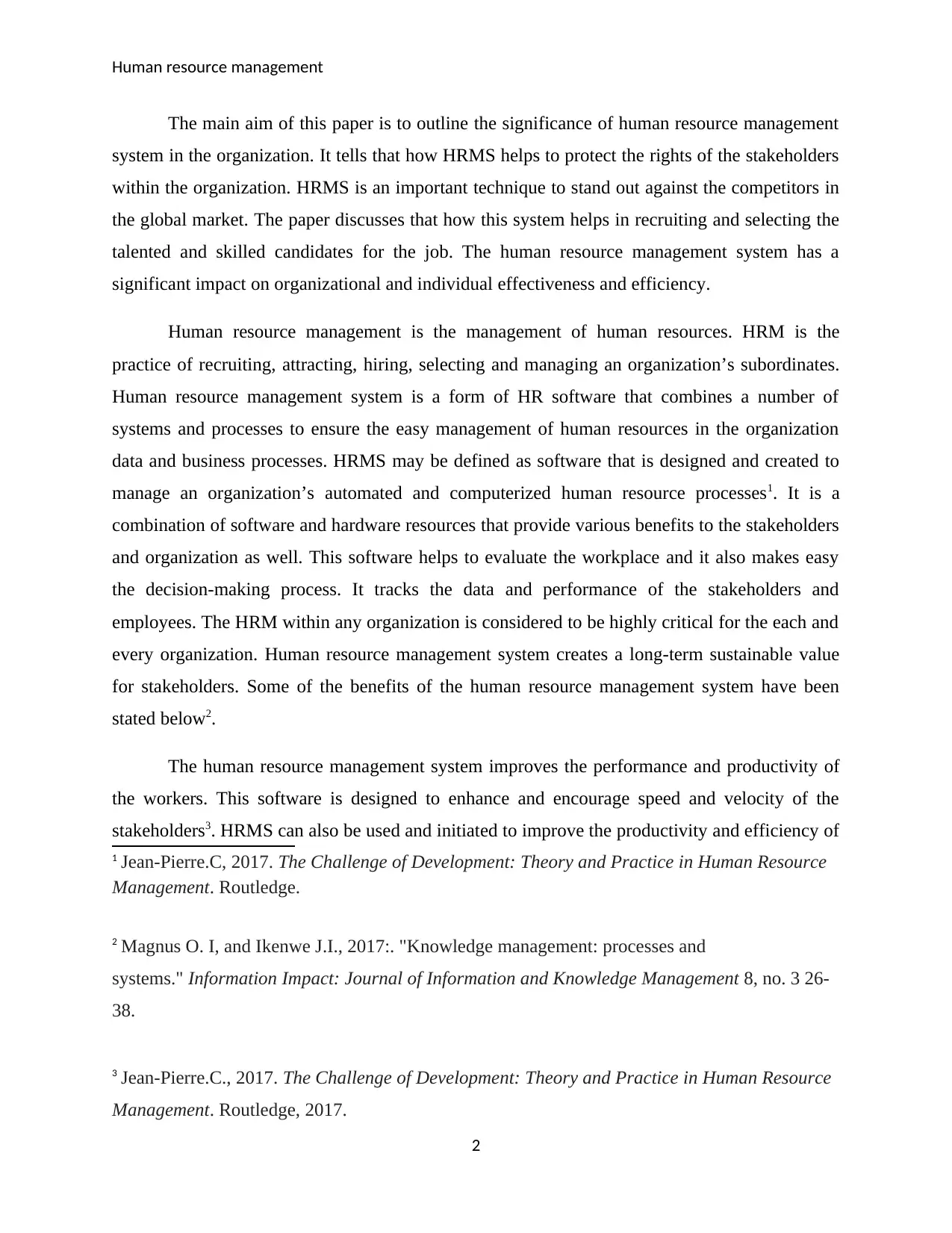
Human resource management
The main aim of this paper is to outline the significance of human resource management
system in the organization. It tells that how HRMS helps to protect the rights of the stakeholders
within the organization. HRMS is an important technique to stand out against the competitors in
the global market. The paper discusses that how this system helps in recruiting and selecting the
talented and skilled candidates for the job. The human resource management system has a
significant impact on organizational and individual effectiveness and efficiency.
Human resource management is the management of human resources. HRM is the
practice of recruiting, attracting, hiring, selecting and managing an organization’s subordinates.
Human resource management system is a form of HR software that combines a number of
systems and processes to ensure the easy management of human resources in the organization
data and business processes. HRMS may be defined as software that is designed and created to
manage an organization’s automated and computerized human resource processes1. It is a
combination of software and hardware resources that provide various benefits to the stakeholders
and organization as well. This software helps to evaluate the workplace and it also makes easy
the decision-making process. It tracks the data and performance of the stakeholders and
employees. The HRM within any organization is considered to be highly critical for the each and
every organization. Human resource management system creates a long-term sustainable value
for stakeholders. Some of the benefits of the human resource management system have been
stated below2.
The human resource management system improves the performance and productivity of
the workers. This software is designed to enhance and encourage speed and velocity of the
stakeholders3. HRMS can also be used and initiated to improve the productivity and efficiency of
1 Jean-Pierre.C, 2017. The Challenge of Development: Theory and Practice in Human Resource
Management. Routledge.
2 Magnus O. I, and Ikenwe J.I., 2017:. "Knowledge management: processes and
systems." Information Impact: Journal of Information and Knowledge Management 8, no. 3 26-
38.
3 Jean-Pierre.C., 2017. The Challenge of Development: Theory and Practice in Human Resource
Management. Routledge, 2017.
2
The main aim of this paper is to outline the significance of human resource management
system in the organization. It tells that how HRMS helps to protect the rights of the stakeholders
within the organization. HRMS is an important technique to stand out against the competitors in
the global market. The paper discusses that how this system helps in recruiting and selecting the
talented and skilled candidates for the job. The human resource management system has a
significant impact on organizational and individual effectiveness and efficiency.
Human resource management is the management of human resources. HRM is the
practice of recruiting, attracting, hiring, selecting and managing an organization’s subordinates.
Human resource management system is a form of HR software that combines a number of
systems and processes to ensure the easy management of human resources in the organization
data and business processes. HRMS may be defined as software that is designed and created to
manage an organization’s automated and computerized human resource processes1. It is a
combination of software and hardware resources that provide various benefits to the stakeholders
and organization as well. This software helps to evaluate the workplace and it also makes easy
the decision-making process. It tracks the data and performance of the stakeholders and
employees. The HRM within any organization is considered to be highly critical for the each and
every organization. Human resource management system creates a long-term sustainable value
for stakeholders. Some of the benefits of the human resource management system have been
stated below2.
The human resource management system improves the performance and productivity of
the workers. This software is designed to enhance and encourage speed and velocity of the
stakeholders3. HRMS can also be used and initiated to improve the productivity and efficiency of
1 Jean-Pierre.C, 2017. The Challenge of Development: Theory and Practice in Human Resource
Management. Routledge.
2 Magnus O. I, and Ikenwe J.I., 2017:. "Knowledge management: processes and
systems." Information Impact: Journal of Information and Knowledge Management 8, no. 3 26-
38.
3 Jean-Pierre.C., 2017. The Challenge of Development: Theory and Practice in Human Resource
Management. Routledge, 2017.
2
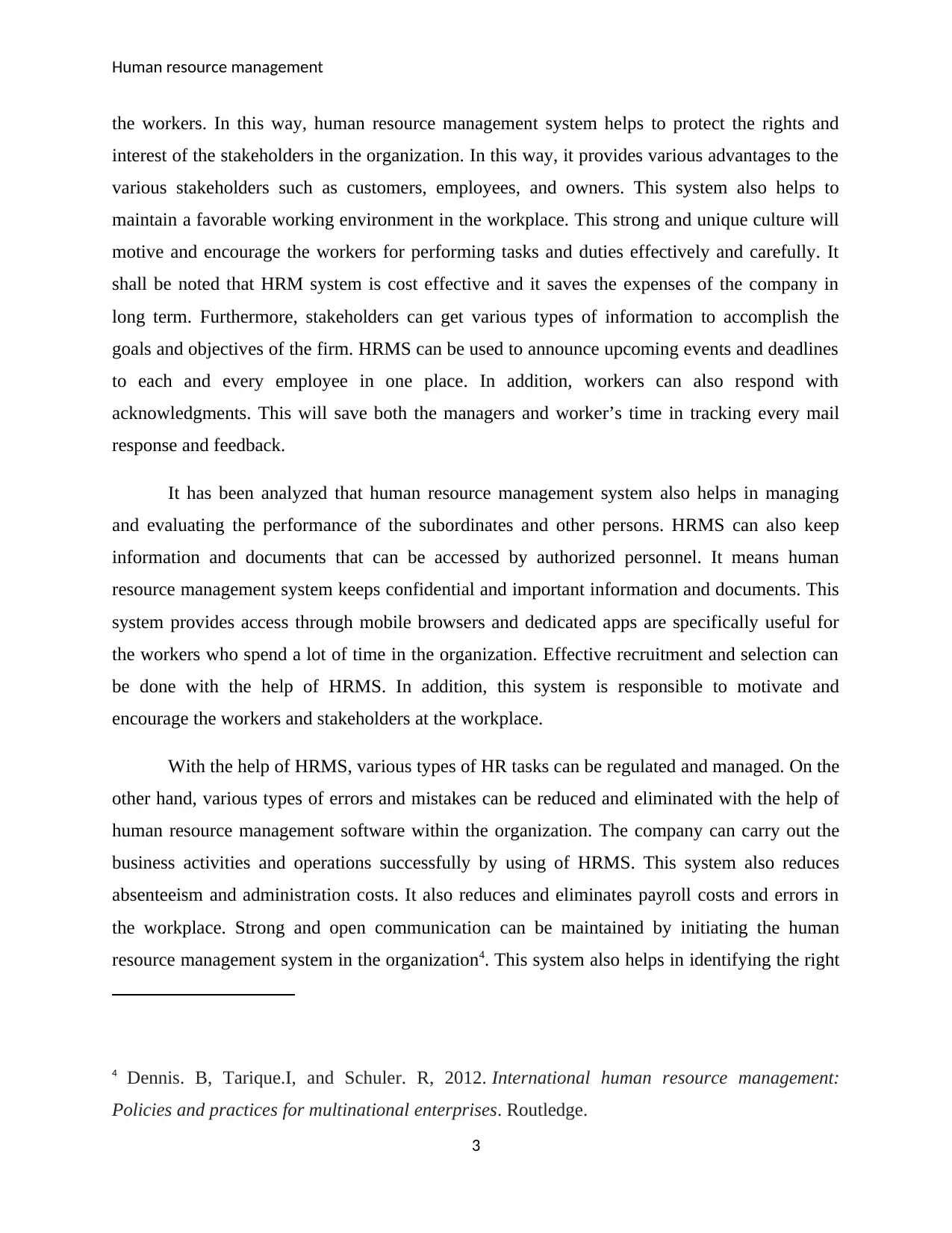
Human resource management
the workers. In this way, human resource management system helps to protect the rights and
interest of the stakeholders in the organization. In this way, it provides various advantages to the
various stakeholders such as customers, employees, and owners. This system also helps to
maintain a favorable working environment in the workplace. This strong and unique culture will
motive and encourage the workers for performing tasks and duties effectively and carefully. It
shall be noted that HRM system is cost effective and it saves the expenses of the company in
long term. Furthermore, stakeholders can get various types of information to accomplish the
goals and objectives of the firm. HRMS can be used to announce upcoming events and deadlines
to each and every employee in one place. In addition, workers can also respond with
acknowledgments. This will save both the managers and worker’s time in tracking every mail
response and feedback.
It has been analyzed that human resource management system also helps in managing
and evaluating the performance of the subordinates and other persons. HRMS can also keep
information and documents that can be accessed by authorized personnel. It means human
resource management system keeps confidential and important information and documents. This
system provides access through mobile browsers and dedicated apps are specifically useful for
the workers who spend a lot of time in the organization. Effective recruitment and selection can
be done with the help of HRMS. In addition, this system is responsible to motivate and
encourage the workers and stakeholders at the workplace.
With the help of HRMS, various types of HR tasks can be regulated and managed. On the
other hand, various types of errors and mistakes can be reduced and eliminated with the help of
human resource management software within the organization. The company can carry out the
business activities and operations successfully by using of HRMS. This system also reduces
absenteeism and administration costs. It also reduces and eliminates payroll costs and errors in
the workplace. Strong and open communication can be maintained by initiating the human
resource management system in the organization4. This system also helps in identifying the right
4 Dennis. B, Tarique.I, and Schuler. R, 2012. International human resource management:
Policies and practices for multinational enterprises. Routledge.
3
the workers. In this way, human resource management system helps to protect the rights and
interest of the stakeholders in the organization. In this way, it provides various advantages to the
various stakeholders such as customers, employees, and owners. This system also helps to
maintain a favorable working environment in the workplace. This strong and unique culture will
motive and encourage the workers for performing tasks and duties effectively and carefully. It
shall be noted that HRM system is cost effective and it saves the expenses of the company in
long term. Furthermore, stakeholders can get various types of information to accomplish the
goals and objectives of the firm. HRMS can be used to announce upcoming events and deadlines
to each and every employee in one place. In addition, workers can also respond with
acknowledgments. This will save both the managers and worker’s time in tracking every mail
response and feedback.
It has been analyzed that human resource management system also helps in managing
and evaluating the performance of the subordinates and other persons. HRMS can also keep
information and documents that can be accessed by authorized personnel. It means human
resource management system keeps confidential and important information and documents. This
system provides access through mobile browsers and dedicated apps are specifically useful for
the workers who spend a lot of time in the organization. Effective recruitment and selection can
be done with the help of HRMS. In addition, this system is responsible to motivate and
encourage the workers and stakeholders at the workplace.
With the help of HRMS, various types of HR tasks can be regulated and managed. On the
other hand, various types of errors and mistakes can be reduced and eliminated with the help of
human resource management software within the organization. The company can carry out the
business activities and operations successfully by using of HRMS. This system also reduces
absenteeism and administration costs. It also reduces and eliminates payroll costs and errors in
the workplace. Strong and open communication can be maintained by initiating the human
resource management system in the organization4. This system also helps in identifying the right
4 Dennis. B, Tarique.I, and Schuler. R, 2012. International human resource management:
Policies and practices for multinational enterprises. Routledge.
3
⊘ This is a preview!⊘
Do you want full access?
Subscribe today to unlock all pages.

Trusted by 1+ million students worldwide
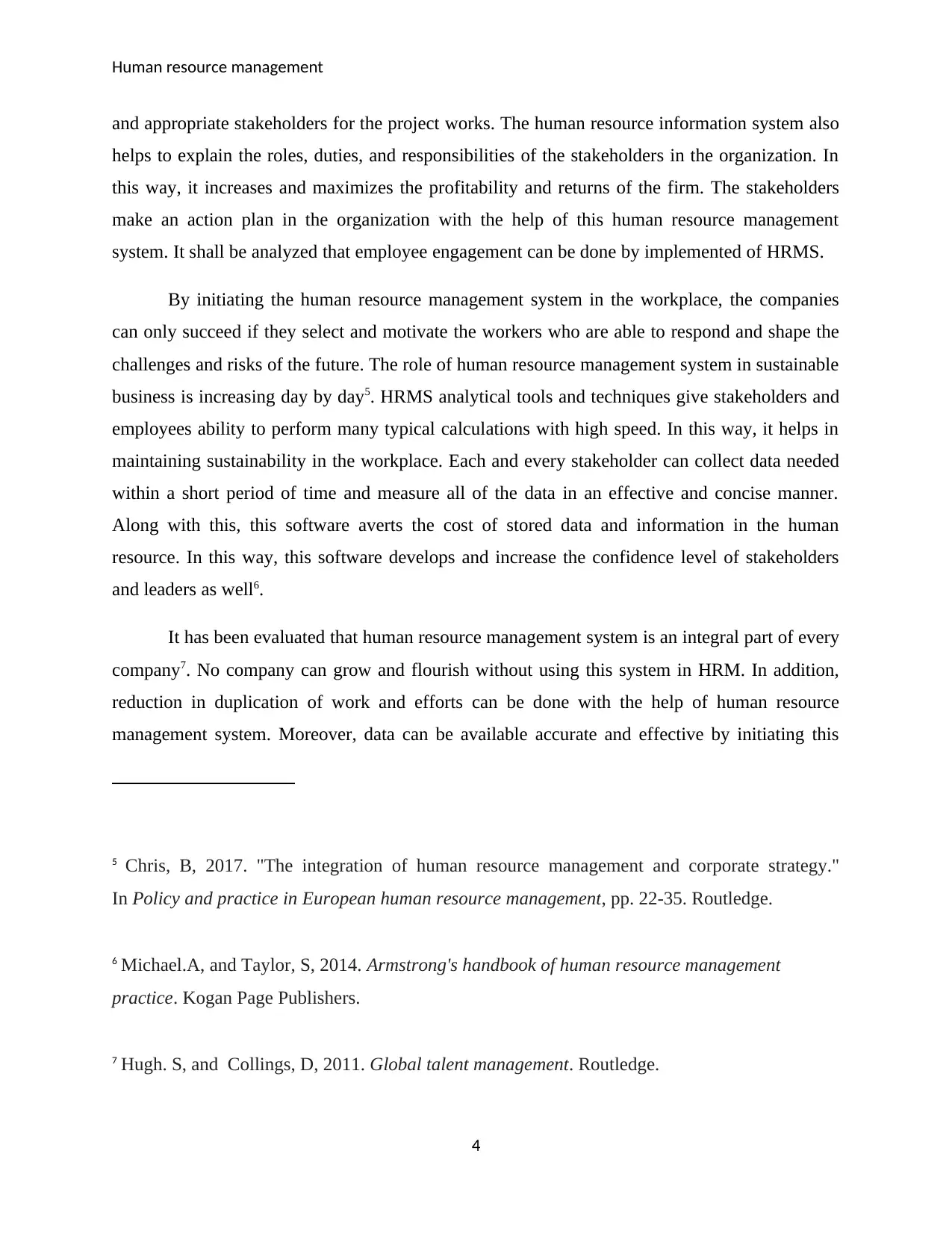
Human resource management
and appropriate stakeholders for the project works. The human resource information system also
helps to explain the roles, duties, and responsibilities of the stakeholders in the organization. In
this way, it increases and maximizes the profitability and returns of the firm. The stakeholders
make an action plan in the organization with the help of this human resource management
system. It shall be analyzed that employee engagement can be done by implemented of HRMS.
By initiating the human resource management system in the workplace, the companies
can only succeed if they select and motivate the workers who are able to respond and shape the
challenges and risks of the future. The role of human resource management system in sustainable
business is increasing day by day5. HRMS analytical tools and techniques give stakeholders and
employees ability to perform many typical calculations with high speed. In this way, it helps in
maintaining sustainability in the workplace. Each and every stakeholder can collect data needed
within a short period of time and measure all of the data in an effective and concise manner.
Along with this, this software averts the cost of stored data and information in the human
resource. In this way, this software develops and increase the confidence level of stakeholders
and leaders as well6.
It has been evaluated that human resource management system is an integral part of every
company7. No company can grow and flourish without using this system in HRM. In addition,
reduction in duplication of work and efforts can be done with the help of human resource
management system. Moreover, data can be available accurate and effective by initiating this
5 Chris, B, 2017. "The integration of human resource management and corporate strategy."
In Policy and practice in European human resource management, pp. 22-35. Routledge.
6 Michael.A, and Taylor, S, 2014. Armstrong's handbook of human resource management
practice. Kogan Page Publishers.
7 Hugh. S, and Collings, D, 2011. Global talent management. Routledge.
4
and appropriate stakeholders for the project works. The human resource information system also
helps to explain the roles, duties, and responsibilities of the stakeholders in the organization. In
this way, it increases and maximizes the profitability and returns of the firm. The stakeholders
make an action plan in the organization with the help of this human resource management
system. It shall be analyzed that employee engagement can be done by implemented of HRMS.
By initiating the human resource management system in the workplace, the companies
can only succeed if they select and motivate the workers who are able to respond and shape the
challenges and risks of the future. The role of human resource management system in sustainable
business is increasing day by day5. HRMS analytical tools and techniques give stakeholders and
employees ability to perform many typical calculations with high speed. In this way, it helps in
maintaining sustainability in the workplace. Each and every stakeholder can collect data needed
within a short period of time and measure all of the data in an effective and concise manner.
Along with this, this software averts the cost of stored data and information in the human
resource. In this way, this software develops and increase the confidence level of stakeholders
and leaders as well6.
It has been evaluated that human resource management system is an integral part of every
company7. No company can grow and flourish without using this system in HRM. In addition,
reduction in duplication of work and efforts can be done with the help of human resource
management system. Moreover, data can be available accurate and effective by initiating this
5 Chris, B, 2017. "The integration of human resource management and corporate strategy."
In Policy and practice in European human resource management, pp. 22-35. Routledge.
6 Michael.A, and Taylor, S, 2014. Armstrong's handbook of human resource management
practice. Kogan Page Publishers.
7 Hugh. S, and Collings, D, 2011. Global talent management. Routledge.
4
Paraphrase This Document
Need a fresh take? Get an instant paraphrase of this document with our AI Paraphraser
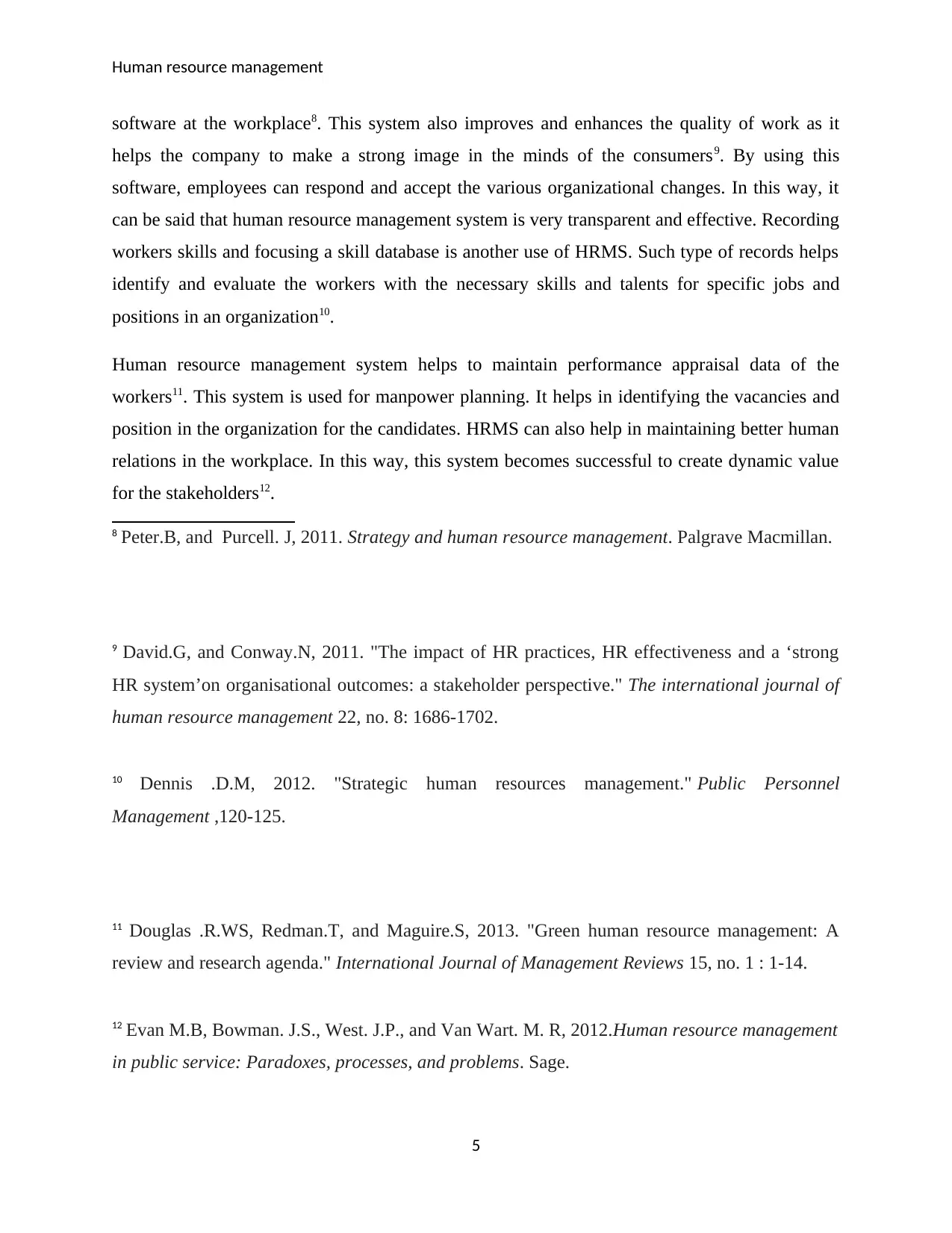
Human resource management
software at the workplace8. This system also improves and enhances the quality of work as it
helps the company to make a strong image in the minds of the consumers9. By using this
software, employees can respond and accept the various organizational changes. In this way, it
can be said that human resource management system is very transparent and effective. Recording
workers skills and focusing a skill database is another use of HRMS. Such type of records helps
identify and evaluate the workers with the necessary skills and talents for specific jobs and
positions in an organization10.
Human resource management system helps to maintain performance appraisal data of the
workers11. This system is used for manpower planning. It helps in identifying the vacancies and
position in the organization for the candidates. HRMS can also help in maintaining better human
relations in the workplace. In this way, this system becomes successful to create dynamic value
for the stakeholders12.
8 Peter.B, and Purcell. J, 2011. Strategy and human resource management. Palgrave Macmillan.
9 David.G, and Conway.N, 2011. "The impact of HR practices, HR effectiveness and a ‘strong
HR system’on organisational outcomes: a stakeholder perspective." The international journal of
human resource management 22, no. 8: 1686-1702.
10 Dennis .D.M, 2012. "Strategic human resources management." Public Personnel
Management ,120-125.
11 Douglas .R.WS, Redman.T, and Maguire.S, 2013. "Green human resource management: A
review and research agenda." International Journal of Management Reviews 15, no. 1 : 1-14.
12 Evan M.B, Bowman. J.S., West. J.P., and Van Wart. M. R, 2012.Human resource management
in public service: Paradoxes, processes, and problems. Sage.
5
software at the workplace8. This system also improves and enhances the quality of work as it
helps the company to make a strong image in the minds of the consumers9. By using this
software, employees can respond and accept the various organizational changes. In this way, it
can be said that human resource management system is very transparent and effective. Recording
workers skills and focusing a skill database is another use of HRMS. Such type of records helps
identify and evaluate the workers with the necessary skills and talents for specific jobs and
positions in an organization10.
Human resource management system helps to maintain performance appraisal data of the
workers11. This system is used for manpower planning. It helps in identifying the vacancies and
position in the organization for the candidates. HRMS can also help in maintaining better human
relations in the workplace. In this way, this system becomes successful to create dynamic value
for the stakeholders12.
8 Peter.B, and Purcell. J, 2011. Strategy and human resource management. Palgrave Macmillan.
9 David.G, and Conway.N, 2011. "The impact of HR practices, HR effectiveness and a ‘strong
HR system’on organisational outcomes: a stakeholder perspective." The international journal of
human resource management 22, no. 8: 1686-1702.
10 Dennis .D.M, 2012. "Strategic human resources management." Public Personnel
Management ,120-125.
11 Douglas .R.WS, Redman.T, and Maguire.S, 2013. "Green human resource management: A
review and research agenda." International Journal of Management Reviews 15, no. 1 : 1-14.
12 Evan M.B, Bowman. J.S., West. J.P., and Van Wart. M. R, 2012.Human resource management
in public service: Paradoxes, processes, and problems. Sage.
5
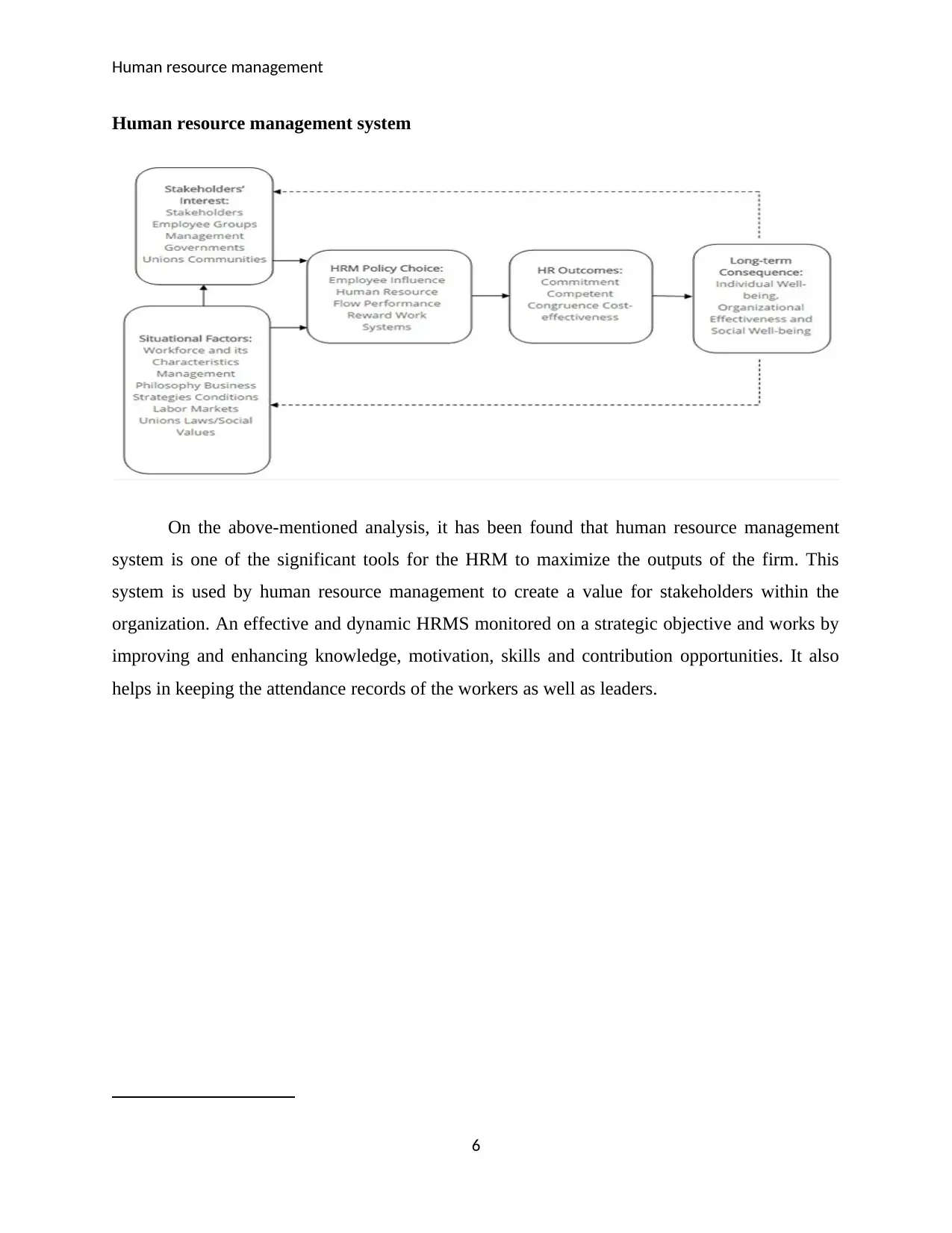
Human resource management
Human resource management system
On the above-mentioned analysis, it has been found that human resource management
system is one of the significant tools for the HRM to maximize the outputs of the firm. This
system is used by human resource management to create a value for stakeholders within the
organization. An effective and dynamic HRMS monitored on a strategic objective and works by
improving and enhancing knowledge, motivation, skills and contribution opportunities. It also
helps in keeping the attendance records of the workers as well as leaders.
6
Human resource management system
On the above-mentioned analysis, it has been found that human resource management
system is one of the significant tools for the HRM to maximize the outputs of the firm. This
system is used by human resource management to create a value for stakeholders within the
organization. An effective and dynamic HRMS monitored on a strategic objective and works by
improving and enhancing knowledge, motivation, skills and contribution opportunities. It also
helps in keeping the attendance records of the workers as well as leaders.
6
⊘ This is a preview!⊘
Do you want full access?
Subscribe today to unlock all pages.

Trusted by 1+ million students worldwide
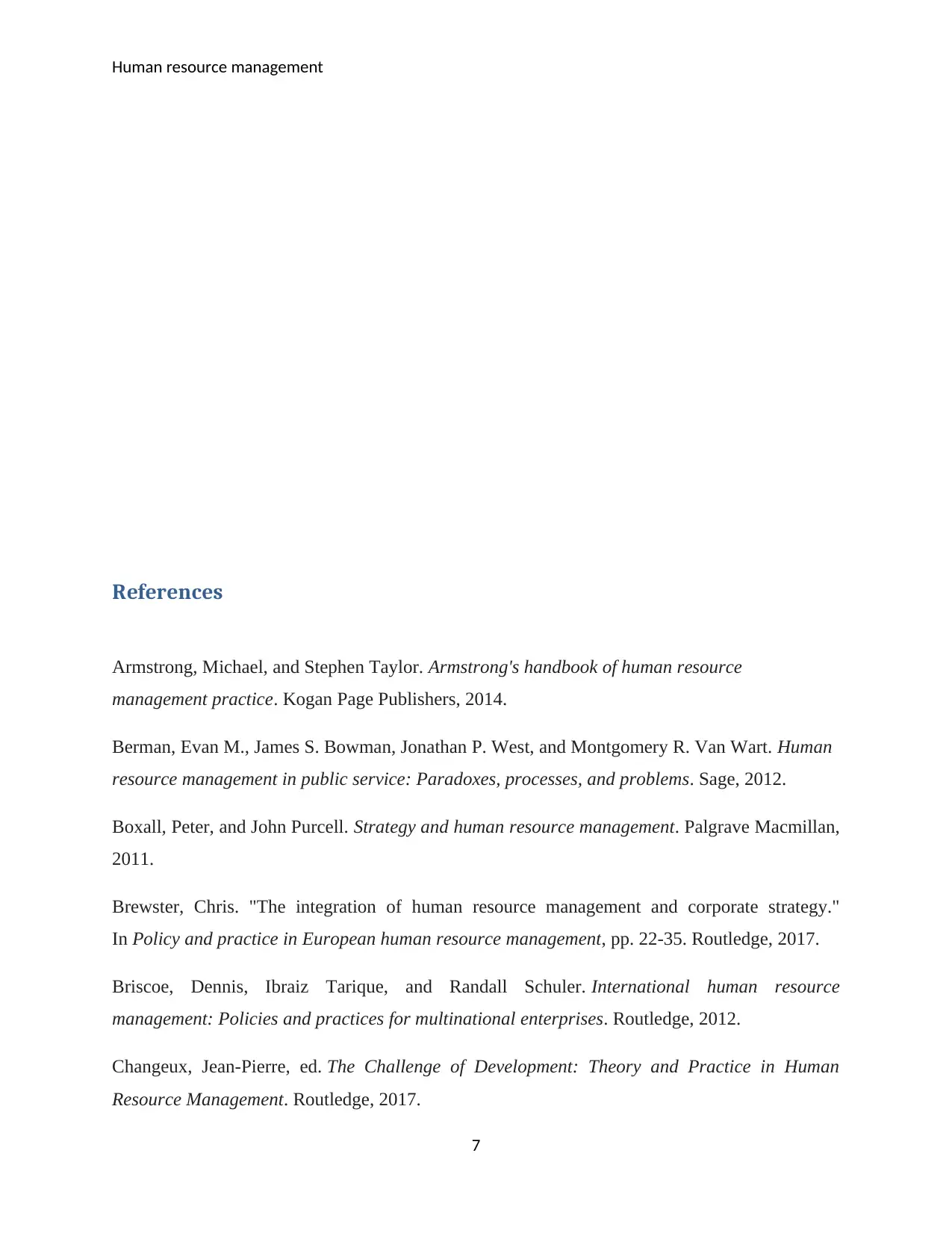
Human resource management
References
Armstrong, Michael, and Stephen Taylor. Armstrong's handbook of human resource
management practice. Kogan Page Publishers, 2014.
Berman, Evan M., James S. Bowman, Jonathan P. West, and Montgomery R. Van Wart. Human
resource management in public service: Paradoxes, processes, and problems. Sage, 2012.
Boxall, Peter, and John Purcell. Strategy and human resource management. Palgrave Macmillan,
2011.
Brewster, Chris. "The integration of human resource management and corporate strategy."
In Policy and practice in European human resource management, pp. 22-35. Routledge, 2017.
Briscoe, Dennis, Ibraiz Tarique, and Randall Schuler. International human resource
management: Policies and practices for multinational enterprises. Routledge, 2012.
Changeux, Jean-Pierre, ed. The Challenge of Development: Theory and Practice in Human
Resource Management. Routledge, 2017.
7
References
Armstrong, Michael, and Stephen Taylor. Armstrong's handbook of human resource
management practice. Kogan Page Publishers, 2014.
Berman, Evan M., James S. Bowman, Jonathan P. West, and Montgomery R. Van Wart. Human
resource management in public service: Paradoxes, processes, and problems. Sage, 2012.
Boxall, Peter, and John Purcell. Strategy and human resource management. Palgrave Macmillan,
2011.
Brewster, Chris. "The integration of human resource management and corporate strategy."
In Policy and practice in European human resource management, pp. 22-35. Routledge, 2017.
Briscoe, Dennis, Ibraiz Tarique, and Randall Schuler. International human resource
management: Policies and practices for multinational enterprises. Routledge, 2012.
Changeux, Jean-Pierre, ed. The Challenge of Development: Theory and Practice in Human
Resource Management. Routledge, 2017.
7
Paraphrase This Document
Need a fresh take? Get an instant paraphrase of this document with our AI Paraphraser
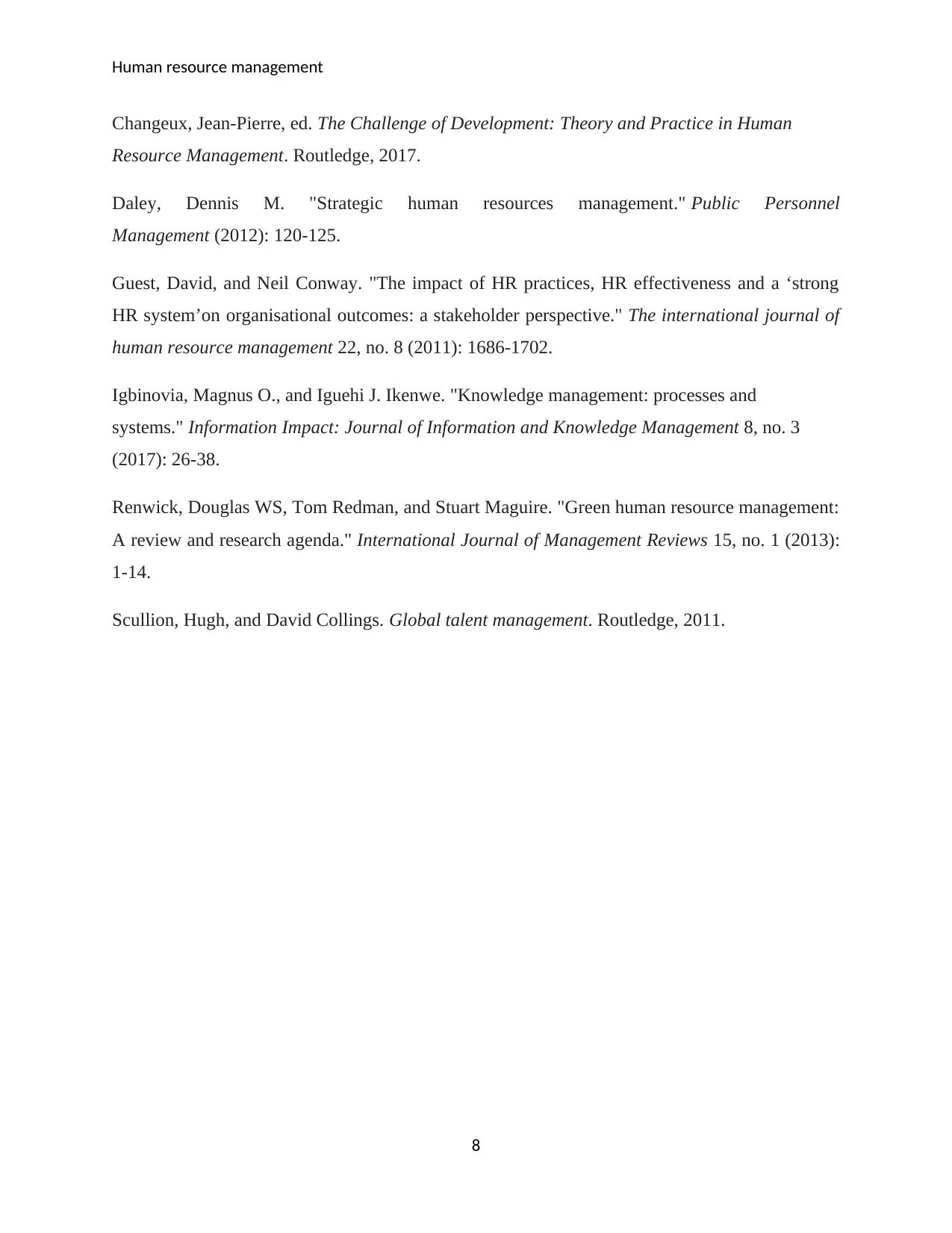
Human resource management
Changeux, Jean-Pierre, ed. The Challenge of Development: Theory and Practice in Human
Resource Management. Routledge, 2017.
Daley, Dennis M. "Strategic human resources management." Public Personnel
Management (2012): 120-125.
Guest, David, and Neil Conway. "The impact of HR practices, HR effectiveness and a ‘strong
HR system’on organisational outcomes: a stakeholder perspective." The international journal of
human resource management 22, no. 8 (2011): 1686-1702.
Igbinovia, Magnus O., and Iguehi J. Ikenwe. "Knowledge management: processes and
systems." Information Impact: Journal of Information and Knowledge Management 8, no. 3
(2017): 26-38.
Renwick, Douglas WS, Tom Redman, and Stuart Maguire. "Green human resource management:
A review and research agenda." International Journal of Management Reviews 15, no. 1 (2013):
1-14.
Scullion, Hugh, and David Collings. Global talent management. Routledge, 2011.
8
Changeux, Jean-Pierre, ed. The Challenge of Development: Theory and Practice in Human
Resource Management. Routledge, 2017.
Daley, Dennis M. "Strategic human resources management." Public Personnel
Management (2012): 120-125.
Guest, David, and Neil Conway. "The impact of HR practices, HR effectiveness and a ‘strong
HR system’on organisational outcomes: a stakeholder perspective." The international journal of
human resource management 22, no. 8 (2011): 1686-1702.
Igbinovia, Magnus O., and Iguehi J. Ikenwe. "Knowledge management: processes and
systems." Information Impact: Journal of Information and Knowledge Management 8, no. 3
(2017): 26-38.
Renwick, Douglas WS, Tom Redman, and Stuart Maguire. "Green human resource management:
A review and research agenda." International Journal of Management Reviews 15, no. 1 (2013):
1-14.
Scullion, Hugh, and David Collings. Global talent management. Routledge, 2011.
8
1 out of 8
Related Documents
Your All-in-One AI-Powered Toolkit for Academic Success.
+13062052269
info@desklib.com
Available 24*7 on WhatsApp / Email
![[object Object]](/_next/static/media/star-bottom.7253800d.svg)
Unlock your academic potential
Copyright © 2020–2025 A2Z Services. All Rights Reserved. Developed and managed by ZUCOL.





